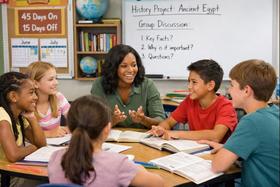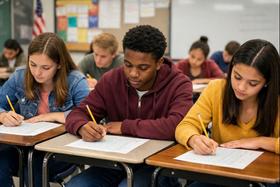San Carlos High School in San Carlos, AZ has a student–teacher ratio of 13:1 based on 2020 data, which is typical for the San Carlos Unified District.
The school's graduation rate increased to 86% in 2023, which is higher than the Arizona state average of 77% and the district rate of 73%.
Math proficiency at San Carlos High School was 5% in 2023, considerably lower than the state average of 34% and roughly equal to the district average of 6%.
Reading proficiency stood at approximately 30% in 2022, which is lower than the state average of 40% and higher than the district average of 5%.
Enrollment decreased from 402 students in 2008 to 278 students in 2020, reflecting a notable decline in the student body size over recent years.
School Overview
Grades Offered
Grades 9-12
Total Students (19-20)
278 students
Total Classroom Teachers (19-20)
22 teachers
School Rankings
Math Test Scores (% Proficient)
(18-19)≤20%
45%
Reading/Language Arts Test Scores (% Proficient)
(18-19)≤20%
45%
Student-Teacher Ratio
n/a
17:1
American Indian
(19-20)99%
6%
Asian
(19-20)n/a
3%
Hispanic
(19-20)n/a
45%
Black
(19-20)n/a
5%
White
(19-20)1%
38%
Hawaiian
(19-20)n/a
n/a
Two or more races
(19-20)n/a
3%
Graduation Rate
(18-19)≥90%
78%
Eligible for Free Lunch (19-20)
1%
43%
Eligible for Reduced Lunch (19-20)
100%
7%
School Statewide Testing
School District Name
Source: National Center for Education Statistics (NCES), AZ Dept. of Education
Frequently Asked Questions
What percent of students have achieved state testing proficiency in math and reading?
≤20% of students have achieved math proficiency (compared to the 45% AZ state average), while ≤20% of students have achieved reading proficiency (compared to the 45% AZ state average).
What is the graduation rate of San Carlos High School?
The graduation rate of San Carlos High School is 90%, which is higher than the Arizona state average of 78%.
How many students attend San Carlos High School?
278 students attend San Carlos High School.
What is the racial composition of the student body?
99% of San Carlos High School students are American Indian, and 1% of students are White.
What grades does San Carlos High School offer ?
San Carlos High School offers enrollment in grades 9-12
What school district is San Carlos High School part of?
San Carlos High School is part of San Carlos Unified District (4210).
Recent Articles

Year-Round Schooling in 2026: Updated Parent Guide
Explore the latest 2026 data, trends, costs, and parent planning tips in the ongoing debate over year-round schooling vs the traditional calendar.

No Child Left Behind: Past, Present, and Future of U.S. School Policy
Explore how No Child Left Behind evolved into ESSA, what it means for 2025‑26 schooling, and what parents need to know about testing, admissions planning, and funding.

Understanding Public School Fees & Optional Costs Guide
Discover what public school fees are required versus optional, with 2026 updates for parents, students, and educators on budgeting and planning.





